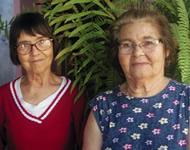 |
Imaculada Conceição Street, in the town of Taubaté (SP), is known as the Figurine Makers Street, in honour of an ancient local tradition of moulding folkloric characters and day-to-day scenes in clay. There are eight houses on the street, all linked to this tradition, but one stands out for keeping alive the tradition of leaving clay pieces to dry in the sun, without firing them. It’s the house of the sisters Luiza and Maria Cândida Alves Santos. Their father Narciso Alves dos Santos, who was a bricklayer and their aunt Mariana, who used to work as a midwife, used to mould clay in their spare time. That’s how they learned their art, together with their sister Edith who passed away in 1997 and who they dearly miss. “We started when we were five years old. Our mother liked it when we were working with clay, because it kept us from running around and getting into trouble. At nine years old our sister Edith used to make figurines to sell at the local market,” says Cândida. They know the story of their street by heart. The first local figurine makers were Dita Paqueira and Maria Evarista, Mrs. Edwiges, Maria Prisciliana and Mrs. Maria Conceição Frutuoso. Like many of the figurine makers before them, the sisters worked at a local factory. When it closed, clay was the answer to keep the money coming in. “Our sister Edith was the first to make the figurine of Our Lady with Flowers. She was inspired by one of our father’s prayer, a family thing. I started making the peacock copying my aunts. But I wanted mine to be different, and so I made it more decorated. Its feathers are all rippled, as I imagined it to be”, says Cândida who is proud of having had her peacock chosen as a symbol of São Paulo’s folklore. Luiza says that on September 13th 2006 it will be exactly 30 years since they first started making clay figurines. It all started when Cândida wanted to make a nativity scene. “Our father bought a can with 18kg of clay. I made a goose and Edith made a rooster. Professor Rossini Tavares helped us a lot, he started the Folklore Museum in São Paulo and always bought our pieces to sell there.” The clay is left to dry under the blazing sun, and they use lively coloured paints to bring the figurines to life. Nearby, the Casa do Figureiro (Figurine Makers House) exhibits pieces by all the local artists. |


